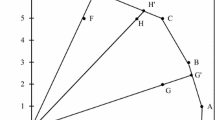Abstract
We conduct a two-stage (DEA and regression) analysis of the efficiency of New Zealand secondary schools. Unlike previous applications of two-stage semi-parametric modelling of the school “production process”, we use Simar and Wilson’s double bootstrap procedure, which permits valid inference in the presence of unknown serial correlation in the efficiency scores. We are therefore able to draw robust conclusions about a system that has undergone extensive reforms with respect to ideas high on the educational agenda such as decentralised school management and parental choice. Most importantly, we find that school type affects school efficiency and so too does teacher quality.


Similar content being viewed by others
Notes
Simar and Wilson (2007) state that 100 replications are “typically sufficient.” We experimented with 500 instead of 100 replications but found no improvements.
We attempted 5,000 and 10,000 replications; however, regressions converged for about only half the replications.
The authors would like to express their thanks to the staff of the Data Management Unit of The New Zealand Ministry of Education, especially Cheryl Remington and Amanda Borich, as well as to Senior Policy Analyst Martin Connelly, for their assistance.
Because of the different possible ways they can be interpreted, our results do not allow us to suggest either increasing or decreasing preferential funding.
The average school roll in our sample is only 732 and schools of over 2,000 students are very rare.
References
Bates JM (1997) Measuring local education authority performance: a frontier approach. Econ Educ Rev 10:19–27
Bradley S, Johnes G, Millington J (2001) The effect of competition on the efficiency of secondary schools in England. Eur J Oper Res 135:545–568
Chalos P (1997) An examination of budgetary inefficiency in education using data envelopment analysis. Financ Account Manage 13:55–69
Duncombe W, Miner J, Ruggiero J (1997) Empirical evaluation of bureaucratic models of inefficiency. Public Choice 93:1–18
Education Review Office (2003) ERO school and early childhood education reports. http://www.ero.govt.nz, Education Review Office, Wellington
Engert F (1996) The reporting of school district efficiency: the adequacy of ratio measures. Public Budgeting Financ Manage 8:247–271
Farrell MJ (1957) The measurement of productive efficiency. J R Stat Soc Ser A 120:253–281
Fiske EB, Ladd H (2000) When schools compete: a cautionary tale. Brookings Institute Press, Washington
Grosskopf S, Hayes KJ, Taylor LL, Weber WL (2001) On the determinants of school district efficiency: competition and monitoring. J Urban Econ 49:453–478
Hadley G (1962) Linear programming. Addison-Wesley, Cambridge, MA
Hanushek EA (2003) The failure of input-based schooling policies. Econ J 113(485):F64–F98
Hanushek EA (2005) The economics of school quality. Ger Econ Rev 6(3):269–286
Jesson D (2000) The comparative evaluation of GCSE value-added performance by type of school and LEA. The University of York discussion papers in economics, 2000/52, University of York, Heslington
Kirjavainen T, Loikkanen HA (1998) Efficiency differences of Finnish senior secondary schools: an application of DEA and Tobit analysis. Econ Educ Rev 17(4):377–394
Kneip A, Park BU, Simar L (1998) A note on the convergence of nonparametric DEA estimates for production efficiency scores. Econom Theory 14:783–793
Kneip A, Simar L, Wilson PW (2003) Asymptotics for DEA estimates in nonparametric frontier models. Discussion paper no. 0317, Université Catholique de Louvain, Louvain-la-Neuve, Belgium
Lewin AY, Minton AW (1986) Determining organizational effectiveness: another look and an agenda for research. Manage Sci 32(5):514–538
Minister of Education (2003) New Zealand schools, Nga Kura o Aotearoa, report of the minister of education on the compulsory schools sector in New Zealand. 2002. Ministry of Education, Wellington
Mizala A, Romaguera P, Farren D (2002) The technical efficiency of schools in Chile. Appl Econ 34:1533–1552
New Zealand Institute of Economic Research (2003) Funding arrangements for independent schools in New Zealand. Report to independent schools of New Zealand by New Zealand Institute of Economic Research (Inc), Wellington
New Zealand Ministry of Education (2003a) Teacher census survey. http://www.minedu.govt.nz, Ministry of Education, Wellington
New Zealand Ministry of Education (2003b) Introduction to school statistics. http://www.minedu.govt.nz, Ministry of Education, Wellington
New Zealand Ministry of Education (2003c) Data description (personal communication). September 2003
New Zealand Ministry of Education (2003d) Operational funding. http://www.minedu.govt.nz, Ministry of Education, Wellington
New Zealand Qualifications Authority (2003) School statistics for 2002 secondary qualifications. http://www.nzqa.govt.nz, New Zealand Qualifications Authority, Wellington
Oliviera MA, Santos C (2005) Assessing school efficiency in Portugal using FDH and bootstrapping. Appl Econ 37:957–968
Ruggiero J (1996) On the measurement of technical efficiency in the public sector. Eur J Oper Res 90:553–565
Shephard RW (1970) Theory of cost and production functions. Princeton University Press, Princeton
Simar L (1996) Aspects of statistical analysis in DEA-type frontier models. J Prod Anal 7:177–185
Simar L, Wilson PW (1998) Sensitivity analysis of efficiency scores: how to bootstrap in nonparametric frontier models. Manage Sci 44:49–61
Simar L, Wilson PW (1999a) Some problems with the Ferrier/Hirschberg bootstrap idea. J Prod Anal 13:67–80
Simar L, Wilson PW (1999b) Of course we can bootstrap DEA scores! But does it mean anything? Logic trumps wishful thinking. J Prod Anal 11:93–97
Simar L, Wilson PW (2000) A general methodology for bootstrapping in non-parametric frontier models. J Appl Stat 27:779–802
Simar L, Wilson PW (2003) Statistical inference in non-parametric frontier models: the state of the art. J Prod Anal 13:49–78
Simar L, Wilson PW (2007) Estimation and inference in two-sage semi-parametric models of production processes. J Econom 136:31–64
Wilson PW (2007) FEAR: a software package for frontier efficiency analysis with R. Socioecon Plann Sci. doi:10.1016/j.seps.2007.02.001
Woodward LJ, Fergusson DM, Horwood LJ (1999) Effects of single-sex and coeducational secondary schooling on children’s academic achievement. Aust J Educ 43(2):142–156
Worthington AC (2001) An empirical survey of frontier efficiency measurement techniques in education. Educ Econ 9(3):245–268
Acknowledgments
The authors thank, without implicating, an anonymous referee of this journal for very helpful suggestions.
Author information
Authors and Affiliations
Corresponding author
Rights and permissions
About this article
Cite this article
Alexander, W.R.J., Haug, A.A. & Jaforullah, M. A two-stage double-bootstrap data envelopment analysis of efficiency differences of New Zealand secondary schools. J Prod Anal 34, 99–110 (2010). https://doi.org/10.1007/s11123-010-0173-3
Published:
Issue Date:
DOI: https://doi.org/10.1007/s11123-010-0173-3




